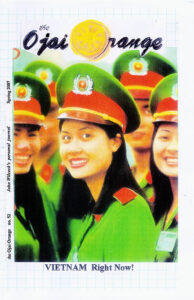
The Column of Lasting Insignificance: March 23, 2013
by John Wilcock
[Six years ago this week I was visiting Vietnam. What follows is the column that resulted from that visit]
Pretty much everything tourists to Vietnam have told you about the country is true. It is beautiful, colorful, vibrant and fascinating. The food is excellent (although you’ll get bored with spring rolls at every meal and welcome the occasional hamburger place), the people are modest and kind, and prices are cheap. (But that won’t last much longer.)
Tourism is going through the roof with 25 million visitors expected this year earning the country $3.5 billion. Visitors from the US have doubled in the past couple of years. United is the only US airline with regular flights.
Business is booming with investors from scores of countries seeking an opening. The Japanese may spend a billion dollars on Ho Chi Minh City’s first subway; South Korean companies have put $3 billion into hotel and residential construction and heavy industry; Intel has just agreed to triple its investment to $1 billion; and Viet Nam News has been carrying stories about shareholders on the Hanoi stock market who are buying lavish flats with trading stock gains.

Of course, the country is still officially communist, but just as in China, the country’s leaders seem to have decided that getting rich is something to promote and there’s a visible gap growing between rich and poor. Out in the countryside, huge Malibu-sized mansions are rising among the rice fields, built by affluent farmers who have gone into other businesses — ceramics, marble statues, tourist souvenirs. This despite the age-old tradition of modesty suggesting they should not make each other envious with overt displays of wealth.
Apart from the garish exhortatory billboards so familiar from the Soviet era and the colorful banners inscribed with hammer and sickle, there is little obvious sign of politics. Even the police, with their dressy green and red uniforms, are unobtrusive and somehow defanged when seen riding on the back of motorbikes like millions of other people. (And millions of motorcycles clogging every street is certainly every visitor’s first impression. Nothing and nobody slows down at pedestrian crossings; the pedestrian takes his or her chances, anticipating the swerving of oncoming traffic. Somehow it seems to work.)
For the Vietnamese, of course, freedom is not as clear as it seems. There is no opposition media, no public protest about anything, and — although readily accessible — the internet is carefully watched, with sites banned that mention subjects such as dissidents or democracy. Recently, even the arts have been under fire with a show, Saigon Open City, scheduled for HCM City’s Fine Arts Museum closed before it could open. One of its curators, a Thai named Gridthiya Gaweewong said: “The Vietnamese say they’ve liberated themselves from the Chinese, the French, the Americans, but now the government is oppressing its own people even as it seeks economic ‘openness.’”
And therein lies the dilemma. Does encouraging capitalism lead automatically to a more democratic system? It hasn’t in China, despite the exuberant eagerness of foreign companies to pump money into that country.
Corruption has been very much in the news here lately (hardly unique to any country). Vietnam’s prime minister Nguyen Tan Dung was confronted with the subject when he spent a couple of hours online last month answering carefully chosen questions from the public. Some people had “paid only lip service” to the fight against corruption, he said, but “the most difficult question I’m facing right now is that I don’t have a sufficient budget to afford a decent living for civil servants to rid the nation of this problem.”
But another problem — what tourism may be doing to the country’s culture and traditions — is growing fast. An English-language magazine, The Guide, ran a story about an ethnic village in the northern mountains called Sapa, whose visitors have increased to 2,000 from 170 since the early 1990s. “Experts worry that the precocious tourist industry and all the changes it has brought may have compromised the old traditions,” Van Huyen wrote, “and some traditions may have gone for good.” He mentions the villagers who used to work in the fields and who now throng the streets selling Chinese-made souvenirs, the young boys who serve as unofficial guides, and the women who pose for pictures — for a fee. Prostitution has also arrived. “The traditional H’mong woman who, her whole life through, never thought of any man but her husband, is now virtually extinct. Marital fidelity is an outdated concept.”
For the present though, tourists may be more concerned by the hazardous driving conditions and the dangers of eating from those enticing street stalls. “Vietnam ranks second among the most dangerous road environments in East Asia,” warned a report by the World Bank, and as for buses, “They are death traps — disasters waiting to happen,” declares Grieg Craft, founder of Asia Injury Fund in Vietnam.
Meanwhile, on the sidewalk, death and sickness lurk among the 14,000 street stalls more than 80 per cent of which are contaminated with micro-organisms according to a recent official study. “We can’t imprison people who eat dirty food, nor do we have a law banning suicide,” wryly comments the Food Administration’s Nguyen Thang Phong. Tales abound of stalls with no facilities to wash dirty dishes before they’re reused, and of waiters who dip their thumbs into bowls of noodles.
But countering all this are the observations from the large colony of expats living in the big cities who apparently brave death and disaster every day — and love it. Pathfinder, an English-language listings info-filled magazine, runs a section on street food listing places for banh my (“like sandwiches only better”), fried rolls, and bun oc (vinegary snails). The ubiquitous pho bo stalls are always packed with customers slurping the traditional noodle soup with pork or beef (add fresh chile, lemon juice, pepper, fish sauce). Pho, now world famous, used to be served by peddlers who carried bowls, chopsticks, and ingredients on one end of a pole, a boiling stock pot over a coal oven on the other. Expats commiserate with each other on how hard it is to leave this beautiful country where a hedonistic life in Hanoi means “a circle of friends, work (if you felt like it), bars, road trips, more bars, and food” as Australian Sarah Studds puts it.
